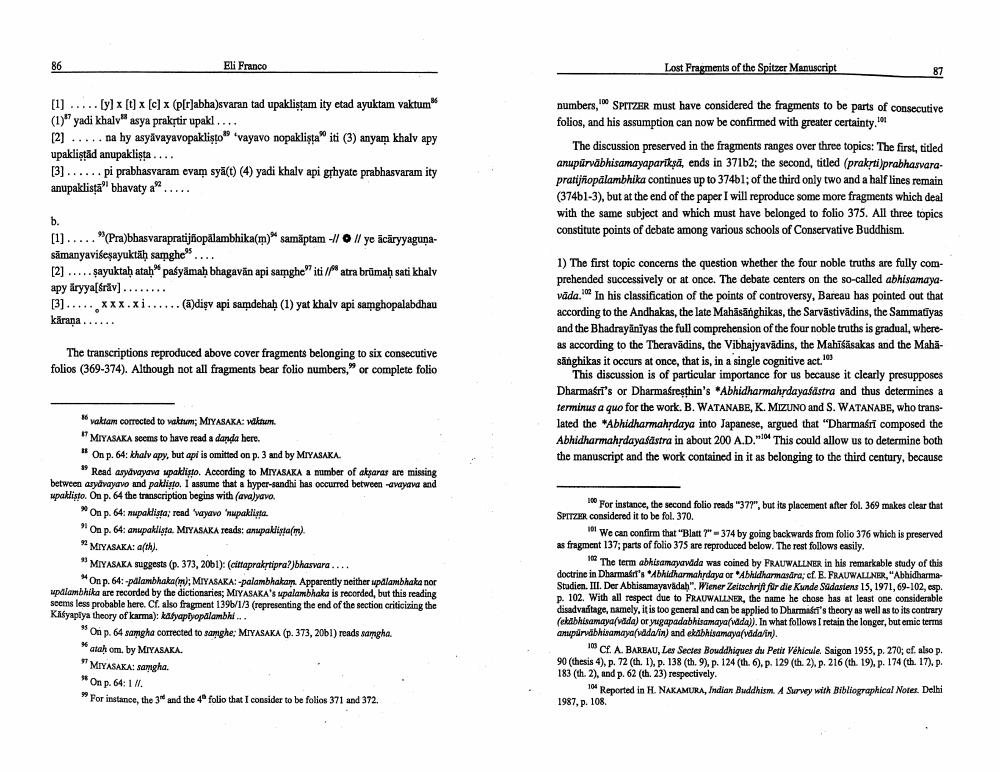Book Title: Lost Fragments Of Spitzer Manuscript Author(s): Eli Franco Publisher: Eli Franco View full book textPage 6
________________ Eli Franco Lost Fragments of the Spitzer Manuscript [1] ..... [y] x [t] (c) * (p[r]abha)svaran tad upaklistam ity etad ayuktam vaktum (1)" yadi khalvasya prakstir upakl.... [2] .....na by asyāvayavopakliştos vayavo nopaklista iti (3) anyam khalv apy upaklistād anupaklista.... (3) ...... pi prabhasyaram evam syāt (4) yadi khalv api grhyate prabhasvaram ity anupallista' bhavaty a numbers, SPITZER must have considered the fragments to be parts of consecutive folios, and his assumption can now be confirmed with greater certainty. The discussion preserved in the fragments ranges over three topics: The first, titled anupūrvābhisamayaparīksā, ends in 371b2; the second, titled (prakti)prabhasvarapratijñopālambhika continues up to 374b1; of the third only two and a half lines remain (374b1-3), but at the end of the paper I will reproduce some more fragments which deal with the same subject and which must have belonged to folio 375. All three topics constitute points of debate among various schools of Conservative Buddhism. [1]..... "(Pra)bbasvarapratijñopālambhika(m) samäptam - // O Il ye acäryyaguņasāmanyavisesayuktāḥ samghe".... [2] ..... sayuktah atah" paśyāmah bhagavān api samghe" iti //atra brumah sati khalv apy äryya[Srav]........ [3].....xxx.xi...... (a)diş api saņdehaḥ (1) yat khalv api samghopalabdhau kärana ...... The transcriptions reproduced above cover fragments belonging to six consecutive folios (369-374). Although not all fragments bear folio numbers, or complete folio 1) The first topic concerns the question whether the four noble truths are fully comprehended successively or at once. The debate centers on the so-called abhisamayavada. In his classification of the points of controversy, Bareau has pointed out that according to the Andhakas, the late Mahāsānghikas, the Sarvāstivādins, the Sammatiyas and the Bhadrayaniyas the full comprehension of the four noble truths is gradual, whereas according to the Theravādins, the Vibhajyavādins, the Mahīšāsakas and the Mahāsänghikas it occurs at once, that is, in a single cognitive act." This discussion is of particular importance for us because it clearly presupposes Dharmasri's or Dharmasresthin's *Abhidharmahrdayaśāstra and thus determines a terminus a quo for the work. B. WATANABE, K. MIZUNO and S. WATANABE, who translated the Abhidharmahrdaya into Japanese, argued that "Dharmasri composed the Abhidharmahrdaya sastra in about 200 A.D.*. This could allow us to determine both the manuscript and the work contained in it as belonging to the third century, because * vaktam corrected to vakuum; MIYASAKA: waktum. "MIYASAKA seems to have read a danda here. "On p. 64: khalv apy, but api is omitted on p. 3 and by MIYASAKA. "Read asuvayava mpaklisto. According to MIYASAKA a number of aksaras are missing between aryavayave and paklisto, I assume that a hyper-sandhi has occurred between awayana and upallisto. On p. 64 the transcription begins with (ava)yavo. On p. 64: nupallista; read wayavo nupaklista "On p. 64: anupaklista. MIYASAKA reads, anupallista(w). * MIYASAKA: 0(th). "MIYASAKA suggests (p. 373, 2001): (cittapraktiprabhaswara.... On p. 64: -diambhaka(); MIYASAKA: -palambhakam. Apparently neither updlambhaka nor upalambhika are recorded by the dictionaries; MIYASAKA's upalambhaka is recorded, but this reading seems less probable here. Cf. also fragment 1396/1/3 (representing the end of the section criticizing the Kasyaplya theory of karma): kafyaplyopdlambhi .. On p. 64 samgha corrected to samghe: MIYASAKA (p. 373, 2011) reads samgha. * ata om. by MIYASAKA. *MIYASAKA: samgha. * On p. 64:1 1. For instance, the 3 and the 4 folio that I consider to be folios 371 and 372. 100 For instance, the second folio reads "377", but its placement after fol. 369 makes clear that SPITZER considered it to be fol. 370. 101 We can confirm that "Blatt" - 374 by going backwards from folio 376 which is preserved as fragment 137; parts of folio 375 are reproduced below. The rest follows easily. The term abhisamawadda was coined by FRAUWALLNER in his remarkable study of this doctrine in Dharmasri's Abhidharmahrdaya or Abluldharmasdra; cf. E. FRAUWALLNER, "AbhidharmaStudien. III. Der Abhisamayavadah". Wiener Zeitschrift für die Kunde Sadasiens 15, 1971, 69-102, esp. p. 102. With all respect due to FRAUWALLNER, the name he chose has at least one considerable disadvantage, namely, it is too general and can be applied to Dharmadit's theory as well as to its contrary (ekabhisamaya(vida) or yugapadabhisamayawada)). In what follows I retain the longer, but emic terms anupurabhisamayavada/in) and ekabhisamaya(vadalin). Cf. A. BARBAU, Les Sectes Bouddhiques du Petit Véhicule. Saigon 1955, p. 270; cf. also p. 90 (thesis 4), p. 72 (th. 1), p. 138 (th. 9).p. 124 (th. 6). p. 129 (th. 2).p. 216 (th. 19), p. 174 (th. 17). p. 183 (th. 2), and p. 62 (th. 23) respectively. 104 Reported in H. NAKAMURA, Indian Buddhism. A Survey with Bibliographical Norer. Delhi 1987, p. 108.Page Navigation
1 ... 4 5 6 7 8 9 10 11 12 13 14 15 16 17 18
